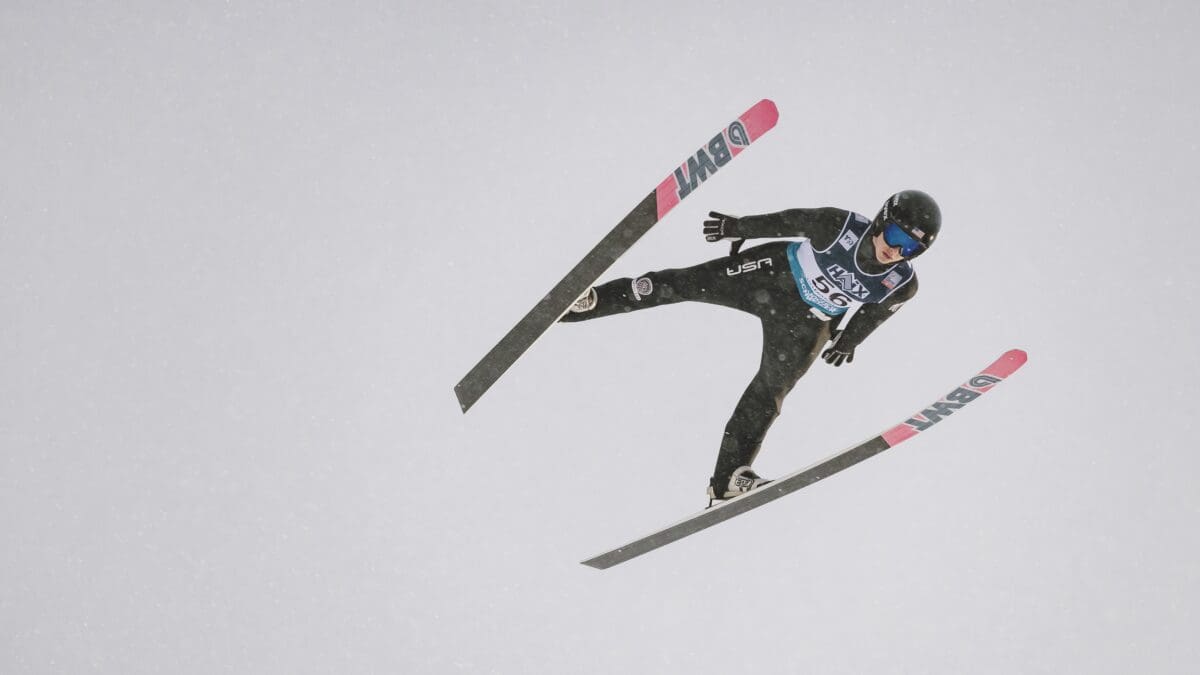Sports
Smart suits: The tech innovation transforming ski jumping competition

Tate Frantz, USA Nordic/U.S. Ski & Snowboard jumper landing in 10th place in Norway world cup. Photo: EXPA/ Tadeusz Mieczynski // courtesy of USA Nordic
The world of ski jumping is undergoing a revolutionary change in how it regulates competition suits. According to a recent FIS article, these suits are “among the most scrutinized equipment in winter sports, and for good reason. As well as having a thickness of 4-6mm, and possessing a specific permeability, excess slack (tolerance) can unfairly aid ‘flight’.”
The sport has long grappled with the challenge of suit regulation, particularly given the significant advantages wealthier nations have enjoyed. Elite jumpers from well-funded programs could cycle through dozens of suits in a single season, while athletes from smaller nations might make do with just a handful all year.
To address this disparity, the International Ski and Snowboard Federation (FIS) has implemented groundbreaking regulations utilizing RFID technology. The new rules restrict athletes to one suit per competition and cap the total at eight suits per FIS Ski Jumping World Cup season, with two additional suits allowed for FIS World Championships.
“The three pillars of the discussion are fairness, financial sustainability and environmental sustainability,” explains Sandro Pertile, FIS Ski Jumping Men’s Race Director.
The impact of suit design on performance cannot be overstated. Pertile emphasizes this point: “Every extra centimeter on a suit counts. If your suit has a 5% bigger surface area, you fly further. Of course, this is a competitive sport and everyone’s on the limit with the rules because everyone wants to win.”
The construction of these suits is intricate, with men’s suits comprising nine sections and women’s suits requiring 11 sections due to different cuts. The suits’ performance deteriorates with use as their air-permeable holes expand, affecting aerodynamics. Previously, teams with larger budgets could simply replace suits frequently to maintain peak performance.
The Technology Behind the Change
The new regulation system employs sophisticated NFC chips heat-pressed onto the suits’ interior. For men’s suits, seven chips are used, while women’s suits receive five, strategically placed in the areas most crucial to flight performance.
Equipment Controller Christian Kathol highlights the system’s security: “The chips cannot be replaced or exchanged from one suit to the next suit. If somebody tries to remove it, even with a knife or a razor blade, it can never be applied again.”
The implementation wasn’t without challenges. Initial testing in Planica revealed technical issues, but as Kathol notes, “On a daily basis, we were solving issues. But we went through the Summer Grand Prix applying the chips and, by the end of it, we were confident that we could introduce the system to the World Cup.”
Financial and Environmental Impact
The new regulations promise significant cost savings. With each suit priced between €600 and €700, reducing usage from 40 to 10 suits per season represents substantial savings for teams. These funds can be redirected toward developing future talent.
The environmental benefits are equally important. The previous practice of discarding suits after minimal use created unnecessary waste. Under the new system, damaged suits can be repaired rather than replaced entirely, with the ability to transfer chips to repaired sections.
Looking Forward
The system’s debut at the FIS World Cup in Lillehammer, Norway (November 22-24) showed promising results, with American athlete Tate Frantz from USA Nordic achieving a milestone top-10 finish.
Women’s Race Director Chika Yoshida offers an optimistic perspective: “We have been testing it at summer competitions and so far, we have received positive feedback from the athletes and coaches… I believe that this system will bring sustainability and fairness to Ski Jumping competitions.”
The initiative has gained support even from traditionally dominant nations like Germany, Austria, Norway, Poland, Japan, and Slovenia. As Pertile notes, “Of course, they have seen that they lose some of their advantage, but we had unanimous approval of the new system when we had to take the final decision in the autumn.”
The impact could reshape the sport’s competitive landscape. As Pertile predicts, “I expect the suit limitations will mean more athletes from more nations will reach the top 10. And for some nations, a top-10 result is like a victory… We really want to be a global sport and not only predominantly a Central European sport.”


















